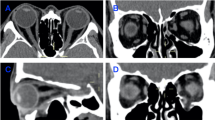Abstract
Purpose
To characterize the location of orbital blowout fractures in Asian individuals.
Methods
This was a retrospective review of 470 consecutive Asian patients with orbital blowout fractures who presented to four tertiary care hospitals in Japan and China. Computed tomography (CT) characterized the location and severity of fractures involving the medial wall, the orbital floor, and/or the maxilloethmoidal strut.
Results
A total of 475 orbital blowout fractures were identified. More than one fracture location was involved in 19 % of all cases. The medial orbital wall was the most commonly involved location, presenting in 29 cases (61 %), of which 204 (43 %) were isolated medial blowout fractures. The orbital floor was the second most common location involved, present in 226 cases (48 %) with 150 isolated orbital floor fractures (32 %), while the maxilloethmoidal strut was involved in 45 cases (9 %) with 30 of those being isolated strut fractures (6 %). The majority of fractures (62 %) were classified as moderately severe, whilst 14 % were mild, and 24 % were severe. Associated nasal fractures were present in 16 % of the cases.
Conclusions
Orbital blowout fractures in Japanese and Chinese individuals occur most commonly in the medial wall. This is in contrast to previous reports on white individuals, who tend to sustain fractures involving the orbital floor rather than the medial wall.

Similar content being viewed by others
References
Gosau M, Schoneich M, Draenert FG, Ettl T, Driemel O, Reichert TE. Retrospective analysis of orbital floor fractures: complications, outcome, and review of literature. Clin Oral Investig. 2011;15:305–13.
De Silva DJ, Rose GE. Orbital blowout fractures and race. Ophthalmology. 2011;118:1677–80.
Chi MJ, Ku M, Shin KH, Baek S. An analysis of 733 surgically treated blowout fractures. Ophthalmologica. 2010;224:167–75.
Jones DE, Evans JN. “Blow-out” fractures of the orbit: an investigation into their anatomical basis. J Laryngol Otol. 1967;81:1109–20.
Gittinger JW Jr, Hughes JP, Suran EL. Medial orbital wall blow-out fracture producing an acquired retraction syndrome. J Clin Neuroophthalmol. 1986;6:153–6.
Jank S, Schuchter B, Emshoff R, Strobl H, Koehler J, Nicasi A, et al. Clinical signs of orbital wall fractures as a function of anatomic location. Oral Surg Oral Med Oral Pathol Oral Radiol Endod. 2003;96:149–53.
Burm JS, Chung CH, Oh SJ. Pure orbital blowout fracture: new concepts and importance of medial orbital blowout fracture. Plast Reconstr Surg. 1999;103:1839–49.
Song WK, Lew H, Yoon JS, Oh MJ, Lee SY. Role of medial orbital wall morphologic properties in orbital blow-out fractures. Invest Ophthalmol Vis Sci. 2009;50:495–9.
Yano H, Nakano M, Anraku K, Suzuki Y, Ishida H, Murakami R, et al. A consecutive case review of orbital blowout fractures and recommendations for comprehensive management. Plast Reconstr Surg. 2009;124:602–11.
Merle H, Gerard M, Raynaud M. Isolated medial orbital blow-out fracture with medial rectus entrapment. Acta Ophthalmol Scand. 1998;76:378–9.
Maisel RH, Acomb TE, Cantrell RW. Medial orbital blow-out fracture: a case report. Laryngoscope. 1975;85:1211–5.
He D, Blomquist PH, Ellis E III. Association between ocular injuries and internal orbital fractures. J Oral Maxillofac Surg. 2007;65:713–20.
Park JS, Lew H, Lee SY. Role of inferior orbital wall morphologic properties in isolated orbital blow-out fracture. Ophthalmic Res. 2012;47:1–6.
Cheng AC, Lucas PW, Yuen HK, Lam DS, So KF. Surgical anatomy of the Chinese orbit. Ophthal Plast Reconstr Surg. 2008;24:136–41.
Ahmad F, Kirkpatrick NA, Lyne J, Urdang M, Waterhouse N. Buckling and hydraulic mechanisms in orbital blowout fractures: fact or fiction? J Craniofac Surg. 2006;17:438–41.
Conflicts of interest
M. T. Sun, None; W. Wu, None; A. Watanabe, None; H. Kakizaki, None; B. Chen, None; K. Ueda, None; N. Katori, None; Y. Takahashi, None; D. Selva, None.
Author information
Authors and Affiliations
Corresponding author
About this article
Cite this article
Sun, M.T., Wu, W., Watanabe, A. et al. Orbital blowout fracture location in Japanese and Chinese patients. Jpn J Ophthalmol 59, 65–69 (2015). https://doi.org/10.1007/s10384-014-0357-x
Received:
Accepted:
Published:
Issue Date:
DOI: https://doi.org/10.1007/s10384-014-0357-x




